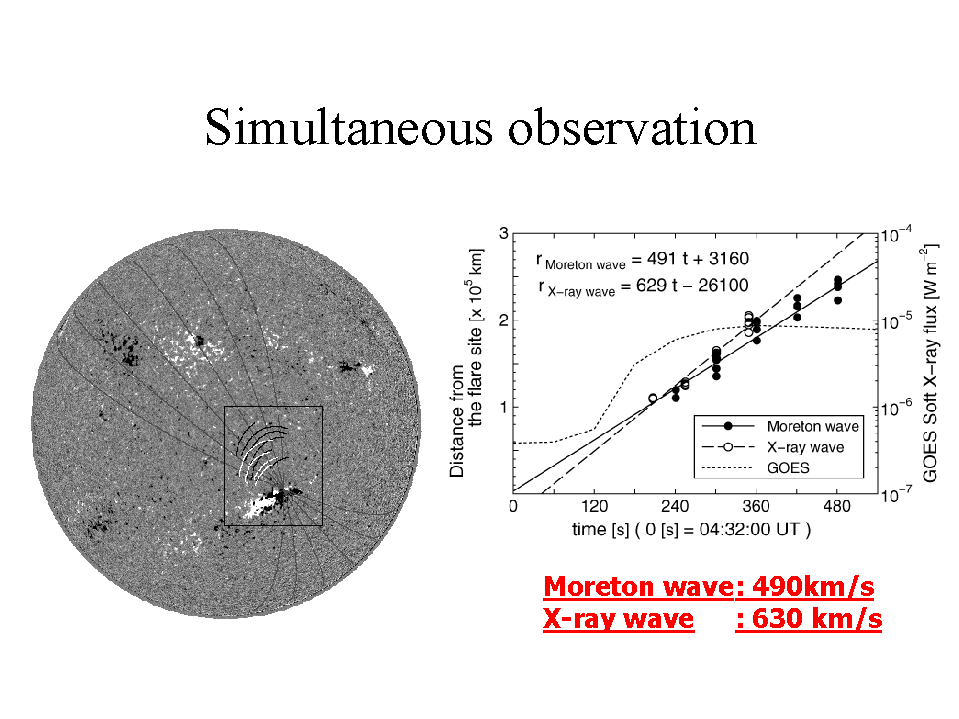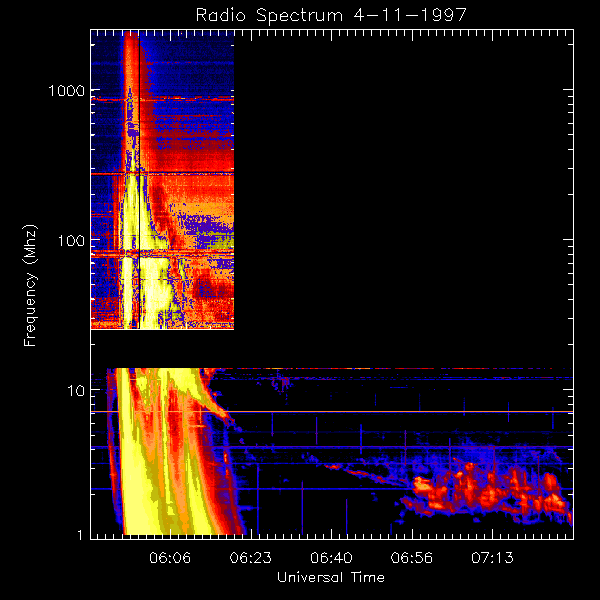 images
in which the latter waves are observed. Only recently, say after 2000,
did H
images
in which the latter waves are observed. Only recently, say after 2000,
did H Moreton waves come to be a research topic again.
Moreton waves come to be a research topic again.
The phenomenon of Moreton waves was first reported in 1960 from
the legendary
Lockheed Observatory. Y. Uchida in his
1968-1974 papers nicely explained Moreton waves as
the intersection of coronal shock waves (due to a flare)
with the chromosphere. But since then there had been surprisingly few
follow-up studies, until coronal waves were detected by
SOHO/EIT (hence called "EIT waves") and got lots of
attention especially in conjunction with CMEs. Interestingly,
many people came to identify EIT waves with the coronal waves that
are responsible for Moreton waves, without actually looking
at H images
in which the latter waves are observed. Only recently, say after 2000,
did H
images
in which the latter waves are observed. Only recently, say after 2000,
did H Moreton waves come to be a research topic again.
Moreton waves come to be a research topic again.
At the Yohkoh meeting, K. Shibata gave an impressive talk to discuss two Moreton wave events, as observed by a small telescope at Hida observatory. The real data analysis was undertaken by his students, of course. His message was that (1) EIT waves are different entities from Moreton waves, and that (2) X-ray waves as detected by Yohkoh SXT, instead, are a coronal counterpart of Moreton waves, therefore signifying fast mode MHD waves as predicted by Uchida. These conclusions are based on the speeds and locations of the three waves.
Moreton waves and EIT waves
The first event was observed on November 4, 1997, at the time of
an intense flare (X2.1 in the NOAA/GOES standard). The reference
for the analysis is S. Eto et al. (submitted to PASJ in January 2002).
This event was
associated with a halo CME, which is considered to be the origin
of a geomagnetic storm that occurred three days later. A movie of
the H off-band (+0.8 Å) images is given
here.
off-band (+0.8 Å) images is given
here.
Moreton waves and X-ray waves
The second event occurred a day before. The flare, in the same
active region, was much less intense (only C8.6), but was again
associated with an extended CME, although very diffuse.
This is one of the extremely rare cases where waves were observed in
H and soft X-rays at the same time. The reference for this work
is N. Narukage et al., submitted to ApJ in February 2002.
and soft X-rays at the same time. The reference for this work
is N. Narukage et al., submitted to ApJ in February 2002.
Click here for
a movie of H |

|
Why are these works important?
In this age of space weather, people often talk about
"CME shocks" as a main agent for solar energetic particle
(SEP) events. Type II bursts in the dekametric and hectometric
wavelengths (observed by
Wind/WAVES, which still sends useful data, to my great relief)
are a familiar signature of CME shocks. They are
often called interplanetary type II bursts because the
frequencies correspond to densities characteristic of the
outer corona, say
2-10 R .
In contrast, metric type II bursts are
usually tied with flare shocks. Although Moreton waves may
intrinsically represent shocks from flares, the two examples dealt
with in this nugget are associated with both metric and hectometric
type II bursts. Are the shocks responsible for these type II
bursts driven by different mechanisms? Please look at the figures
on the right that combine spectra in the two wavelength regimes
(credit to the ISTP Workshop in April 1999), and make your own judgment as
to whether they are not connected. .
In contrast, metric type II bursts are
usually tied with flare shocks. Although Moreton waves may
intrinsically represent shocks from flares, the two examples dealt
with in this nugget are associated with both metric and hectometric
type II bursts. Are the shocks responsible for these type II
bursts driven by different mechanisms? Please look at the figures
on the right that combine spectra in the two wavelength regimes
(credit to the ISTP Workshop in April 1999), and make your own judgment as
to whether they are not connected.
|

|
| Observationally, it seems well established that EIT waves are correlated with CMEs. But Uchida, whose model of Moreton waves is still valid, proposed theory at the Yohkoh meeting on the difference of Moreton and EIT waves in "bubble-type" CMEs that are distinct from "loop-type" CMEs. We are still not sure how much of CME launch/acceleration depends on flare explosions not included in scenarios based on filament-eruption-induced processes. |

|
 telescope not blessed
with good seeing. Therefore, adding an
H
telescope not blessed
with good seeing. Therefore, adding an
H telescope (including off-band
capability) in future missions
such as the Solar
Dynamics Observatory (SDO) may not be a bad idea.
telescope (including off-band
capability) in future missions
such as the Solar
Dynamics Observatory (SDO) may not be a bad idea.
N. Nitta (NVN) (nitta@lmsal.com), with thanks to K. Shibata, S. Eto and N. Narukage.